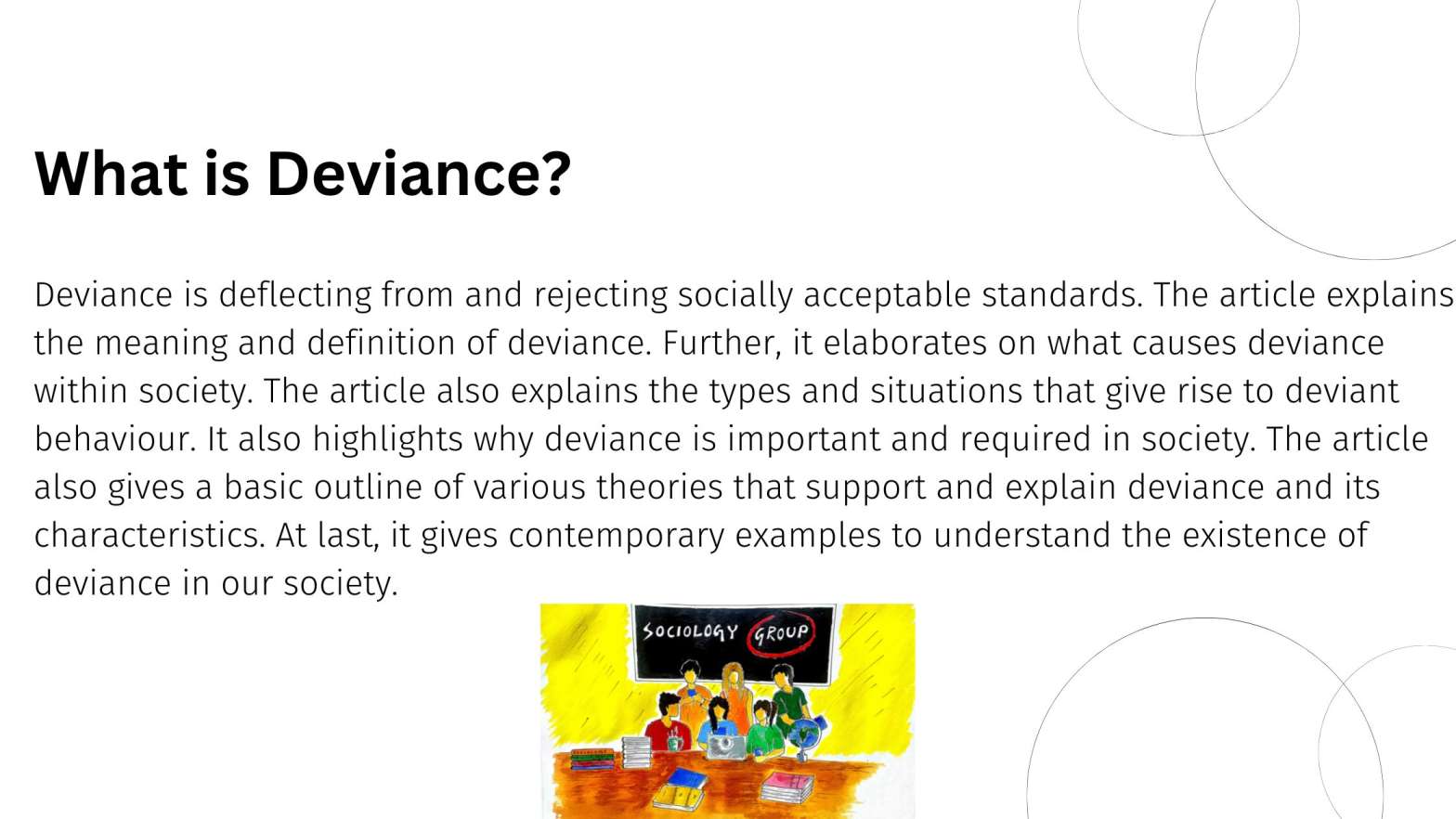Imagine a bustling city street, filled with the cacophony of everyday life. People rush by, each with their own routines and goals. But what happens when someone breaks the unspoken rules of this societal dance? What happens when behavior deviates from the norm, causing a ripple effect of questions and unease? This is the essence of deviance: actions or beliefs that go against what is considered acceptable or normal within a given culture or social group. This concept, while seemingly straightforward, has far-reaching implications for how we understand ourselves, interact with others, and shape the world around us.

Image: www.punktuationmag.com
Deviance is not simply about engaging in criminal activities like stealing or assault. It encompasses a much broader spectrum of actions and beliefs that challenge social norms and expectations. It can be as subtle as wearing clothes considered unorthodox or as impactful as starting a social movement that aims to dismantle established power structures. This article delves into the fascinating realm of deviance, exploring real-life examples that illustrate the complexity and nuances of this concept.
Deviance: A Spectrum of Actions and Beliefs
Deviance is not a fixed entity; it’s a fluid concept that shifts depending on the context. What might be considered deviant in one society or time period may be commonplace in another. Take, for instance, the use of tattoos. In some cultures, tattoos are deeply ingrained into traditions and rituals, while in others they are seen as rebellious or even taboo. Likewise, what’s considered acceptable attire in a corporate setting may be deemed inappropriate at a music festival.
This dynamic nature of deviance emphasizes the importance of understanding the social and cultural factors that influence what’s considered “normal.” We can better comprehend the complexities of deviance when we are aware of these factors and how they shape our perceptions of what is right or wrong, acceptable or unacceptable.
Real-Life Examples of Deviance: From Subtle to Societal
Let’s explore some real-life examples of deviance across diverse contexts:
1. Fashion and Individuality
The fashion industry, often considered a barometer of societal shifts, offers numerous examples of deviant behavior. A youthful individual sporting a brightly colored, outlandish outfit in a conservative corporate environment might initially evoke surprise or even disapproval. The same attire, however, may be perfectly acceptable in a creative field like art or music. This shows how deviance is not inherently negative, but rather influenced by the context and the expectations of the social group.

Image: sociologygroup.com
2. Social Movements and Activism
Throughout history, social movements have often been fueled by acts of deviance. Leaders like Martin Luther King Jr., Malala Yousafzai, and Greta Thunberg all challenged prevailing norms and societal structures through their activism. Their actions, although defying traditional power structures, have led to significant social change and the expansion of rights for marginalized groups. These figures demonstrate the potential of deviance to serve as a catalyst for progress and justice.
3. Technology and Innovation
The rapid pace of technological advancements often pushes the boundaries of societal norms. When personal computers were first introduced, they were considered a radical and potentially disruptive innovation. Similarly, the rise of social media platforms like Instagram and TikTok, with their emphasis on sharing personal experiences and curated online identities, has drastically altered how we communicate and interact with the world. These technological advancements, while initially met with skepticism and concern about their potential societal impact, have ultimately reshaped our way of life.
4. Religious Beliefs and Practices
Religious beliefs can be a powerful source of identity and influence behavior. Certain religious practices, such as the consumption of certain foods or the observance of specific holidays, may be considered deviant by those outside the faith. For instance, the practice of wearing a hijab in some cultures can be seen as a sign of modesty and religious devotion, while in others it may be interpreted as a sign of oppression or social isolation. These contrasting perspectives highlight the importance of understanding the cultural context and values that shape our perceptions of deviance.
5. Cultural Norms and Intercultural Differences
Traveling to a foreign country can be an eye-opening experience, as one encounters a multitude of cultural norms and traditions that may differ significantly from those we are accustomed to. For instance, in some cultures, direct eye contact during conversations is considered a sign of respect, while in others it can be interpreted as aggression. These nuances demonstrate how seemingly innocuous acts, such as maintaining eye contact, can be considered deviant when they go against the established social norms of a particular culture.
The Consequences of Deviance
Deviance rarely exists in a vacuum. It often triggers responses from the individuals and society around it. These responses can range from mild disapproval or social isolation to more severe forms of punishment, including fines, imprisonment, or even ostracism. The severity of the consequences often depends on the perceived harmfulness of the deviant act and the social power dynamics at play.
Understanding the Role of Deviance in Society
While deviance can be challenging and disruptive, it also plays a crucial role in society. It serves as a barometer of societal values and helps to define what is considered acceptable or unacceptable behavior. It can also be a catalyst for social change, as individuals and groups challenge the status quo and push for a more just and equitable society.
The Importance of Tolerance and Empathy in a World of Deviance
As we navigate a world filled with a diverse array of behaviors and beliefs, it’s crucial to approach deviance with tolerance, empathy, and an open mind. Recognizing the complexities of this concept can help us move beyond simplistic judgments and foster a more understanding and inclusive society.
Deviance Examples In Real Life
Conclusion
Deviance is a complex and multifaceted phenomenon that transcends simple notions of right and wrong. It shapes our understanding of ourselves, others, and society as a whole. By exploring real-life examples and understanding the nuances of deviance, we can gain a deeper appreciation for the diversity of human behavior and the fluid nature of social norms. Let’s strive to approach this concept with curiosity, empathy, and a commitment to understanding the complex tapestry of human experiences.






